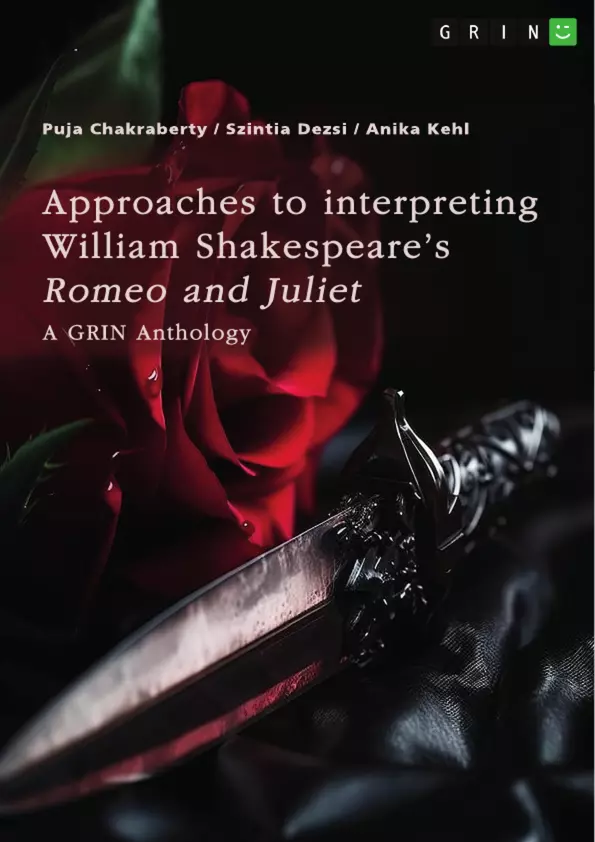This anthology consists of three term papers.
The first paper primarily endeavours to elaborate upon the basic conception of tragedy as laid out by imminent critics over the ages; to religiously undertake a comprehensive close study of the classic tragedy "Romeo and Juliet" written by William Shakespeare; compare and contrast the previous works relating the story and Shakespeare’s very own interpretation; to critically scrutinize and elucidate upon the theme of love, its nature and quality, which is the deciding factor of the play, with special reference been made to ‘Sonnet no. 116’ by William Shakespeare.
Sight is a leading theme in "Romeo and Juliet" and the frequent use of words relating to visual perception is not random or gratuitous. Therefore, the primary object of the second paper is demonstrating that beside the well-debated forces that govern the action, there are others that may have been neglected. Precisely because readers may focus too much on the love story or on other outstanding elements of the play, such as the comic passages which stand in stark contrast with the tragic theme of the play, a considerable amount of intriguing aspects might escape our attention. These are subtle details, which serve a great purpose in the plot development. On many occasions, vision becomes the cause of a series of events in the play.
Why did Shakespeare’s Romeo and Juliet have to die? The third paper is going to explore three different reasons: the (seemingly) inevitable fate of the “star-crossed lovers”, the danger of immature love and the feud with its consequences for society, family, and coming of age. Ultimately, the paper will try to find out what Shakespeare might have wanted to tell his audience and how his messages are conveyed by recent film adaptations.
Inhaltsverzeichnis (Table of Contents)
- A Close Reading of William Shakespeare's "Romeo and Juliet" with special reference to "Sonnet no.116"
- Abstract
- Introduction
- Close Reading
- Conclusion
- An Insight into the Role of Visual Perception in Romeo and Juliet
- Introduction
- Exploring visual perception – theories of sight
- A Historical Panorama of the Theme of Sight in Relation to Shakespeare
- The dangers of reflection
- Visual perception as a proof for veracity
- Sight and its effects in Romeo and Juliet
- The correlation between love and sight in Romeo and Juliet
- Sight as a catalyst in other instances
- Conclusion
- Why William Shakespeare's Romeo and Juliet had to die
- Introduction
- The play
- Shakespeare's religious background
- Shakespearean Tragedy
- Fate
- Religion
- Immature Love
- Coming of Age
- The feud, its initiators and the effects of a patriarchal society
- Conclusion
- Cinematic Realization
- West Side Story
- Romeo + Juliet
Zielsetzung und Themenschwerpunkte (Objectives and Key Themes)
This anthology explores different approaches to interpreting Shakespeare's "Romeo and Juliet," focusing on key aspects such as the role of visual perception and the reasons behind the tragic deaths of the protagonists. The papers aim to provide insightful analyses of the play, drawing on various critical perspectives and scholarly works.
- Interpretations of Shakespeare's "Romeo and Juliet"
- The role of visual perception in the play
- The thematic exploration of love and its complexities
- Analysis of Shakespearean tragedy and its conventions
- The impact of societal factors on the play's narrative
Zusammenfassung der Kapitel (Chapter Summaries)
A Close Reading of William Shakespeare's "Romeo and Juliet" with special reference to "Sonnet no.116": This paper examines Shakespeare's "Romeo and Juliet" through a close reading lens, comparing and contrasting previous interpretations with Shakespeare's own. It focuses on the theme of love, utilizing Shakespeare's Sonnet 116 for added insight.
An Insight into the Role of Visual Perception in Romeo and Juliet: This paper explores the significance of visual perception in "Romeo and Juliet," examining theories of sight and its historical context within Shakespeare's works. It analyzes how sight influences the play's events and relationships.
Why William Shakespeare's Romeo and Juliet had to die: This paper investigates the reasons behind the tragic deaths of Romeo and Juliet. It explores themes of fate, religion, immature love, the coming-of-age process, and the impact of the feud and patriarchal society.
Schlüsselwörter (Keywords)
Shakespeare, Romeo and Juliet, tragedy, love, visual perception, fate, religion, societal factors, interpretation, close reading, sonnet 116.
- Quote paper
- GRIN Verlag (Hrsg.) (Editor), Puja Chakraberty (Author), Szintia Dezsi (Author), Anika Kehl (Author), 2024, Approaches to interpreting William Shakespeare’s "Romeo and Juliet". Sonnet no.116, the role of visual perception, and the death reasons, Munich, GRIN Verlag, https://www.hausarbeiten.de/document/1513037


